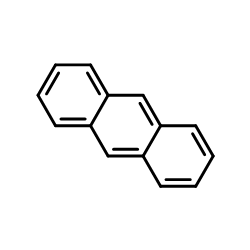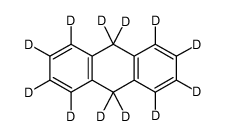(2H10)Anthracene

(2H10)Anthracene structure
|
Common Name | (2H10)Anthracene | ||
|---|---|---|---|---|
| CAS Number | 1719-06-8 | Molecular Weight | 188.291 | |
| Density | 1.1±0.1 g/cm3 | Boiling Point | 337.4±9.0 °C at 760 mmHg | |
| Molecular Formula | C14D10 | Melting Point | 210-215ºC(lit.) | |
| MSDS | Chinese USA | Flash Point | 146.6±12.8 °C | |
| Symbol |


GHS07, GHS09 |
Signal Word | Warning | |
| Name | 1,2,3,4,5,6,7,8,9,10-decadeuterioanthracene |
|---|---|
| Synonym | More Synonyms |
| Density | 1.1±0.1 g/cm3 |
|---|---|
| Boiling Point | 337.4±9.0 °C at 760 mmHg |
| Melting Point | 210-215ºC(lit.) |
| Molecular Formula | C14D10 |
| Molecular Weight | 188.291 |
| Flash Point | 146.6±12.8 °C |
| Exact Mass | 188.141022 |
| LogP | 4.68 |
| Vapour Pressure | 0.0±0.3 mmHg at 25°C |
| Index of Refraction | 1.715 |
| Storage condition | 2-8°C |
Synonym: Section 2 - COMPOSITION, INFORMATION ON INGREDIENTS
Risk Phrases: None Listed. Section 3 - HAZARDS IDENTIFICATION EMERGENCY OVERVIEW
Hygroscopic (absorbs moisture from the air). Potential Health Effects Eye: May cause eye irritation. Skin: Causes mild skin irritation. Ingestion: The toxicological properties of this substance have not been fully investigated. Inhalation: May cause respiratory tract irritation. The toxicological properties of this substance have not been fully investigated. Chronic: Not available. Section 4 - FIRST AID MEASURES Eyes: Flush eyes with plenty of water for at least 15 minutes, occasionally lifting the upper and lower eyelids. Get medical aid. Skin: Get medical aid. Flush skin with plenty of water for at least 15 minutes while removing contaminated clothing and shoes. Ingestion: Get medical aid. Wash mouth out with water. Inhalation: Remove from exposure and move to fresh air immediately. If not breathing, give artificial respiration. If breathing is difficult, give oxygen. Get medical aid. Notes to Physician: Section 5 - FIRE FIGHTING MEASURES General Information: As in any fire, wear a self-contained breathing apparatus in pressure-demand, MSHA/NIOSH (approved or equivalent), and full protective gear. This material in sufficient quantity and reduced particle size is capable of creating a dust explosion. Extinguishing Media: Use water spray, dry chemical, carbon dioxide, or chemical foam. Section 6 - ACCIDENTAL RELEASE MEASURES General Information: Use proper personal protective equipment as indicated in Section 8. Spills/Leaks: Absorb spill with inert material (e.g. vermiculite, sand or earth), then place in suitable container. Section 7 - HANDLING and STORAGE Handling: Avoid breathing dust, vapor, mist, or gas. Avoid contact with skin and eyes. Storage: Store in a cool, dry place. Store in a tightly closed container. Store under nitrogen. Section 8 - EXPOSURE CONTROLS, PERSONAL PROTECTION Engineering Controls: Use adequate ventilation to keep airborne concentrations low. Exposure Limits CAS# 1719-06-8: Personal Protective Equipment Eyes: Not available. Skin: Wear appropriate protective gloves to prevent skin exposure. Clothing: Wear appropriate protective clothing to prevent skin exposure. Respirators: Follow the OSHA respirator regulations found in 29 CFR 1910.134 or European Standard EN 149. Use a NIOSH/MSHA or European Standard EN 149 approved respirator if exposure limits are exceeded or if irritation or other symptoms are experienced. Section 9 - PHYSICAL AND CHEMICAL PROPERTIES Physical State: Powder Color: beige to slight yellow Odor: Not available. pH: Not available. Vapor Pressure: Not available. Viscosity: Not available. Boiling Point: Not available. Freezing/Melting Point: 218-220 deg Autoignition Temperature: Not available. Flash Point: 121 deg C ( 249.80 deg F) Explosion Limits, lower: Not available. Explosion Limits, upper: Not available. Decomposition Temperature: Solubility in water: Insoluble. Specific Gravity/Density: Molecular Formula: C14D10 Molecular Weight: 188.14 Section 10 - STABILITY AND REACTIVITY Chemical Stability: Stable under normal temperatures and pressures. Conditions to Avoid: Incompatible materials, light. Incompatibilities with Other Materials: Strong oxidizing agents, fluorine, acids (mineral, oxidizing, e.g. chromic acid, hypochlorous acid, nitric acid, sulfuric acid), hypochlorite. Hazardous Decomposition Products: Carbon monoxide, carbon dioxide. Hazardous Polymerization: Will not occur. Section 11 - TOXICOLOGICAL INFORMATION RTECS#: CAS# 1719-06-8 unlisted. LD50/LC50: Not available. Carcinogenicity: Anthracene-d10 - Not listed by ACGIH, IARC, or NTP. Section 12 - ECOLOGICAL INFORMATION Section 13 - DISPOSAL CONSIDERATIONS Dispose of in a manner consistent with federal, state, and local regulations. Section 14 - TRANSPORT INFORMATION IATA No information available. IMO No information available. RID/ADR No information available. Section 15 - REGULATORY INFORMATION European/International Regulations European Labeling in Accordance with EC Directives Hazard Symbols: Not available. Risk Phrases: Safety Phrases: S 24/25 Avoid contact with skin and eyes. WGK (Water Danger/Protection) CAS# 1719-06-8: No information available. Canada None of the chemicals in this product are listed on the DSL/NDSL list. CAS# 1719-06-8 is not listed on Canada's Ingredient Disclosure List. US FEDERAL TSCA CAS# 1719-06-8 is not listed on the TSCA inventory. It is for research and development use only. SECTION 16 - ADDITIONAL INFORMATION N/A |
| Symbol |


GHS07, GHS09 |
|---|---|
| Signal Word | Warning |
| Hazard Statements | H315-H319-H335-H410 |
| Precautionary Statements | P261-P273-P305 + P351 + P338-P501 |
| Target Organs | Blood, Central nervous system, Liver |
| Hazard Codes | Xi: Irritant;N: Dangerous for the environment;T: Toxic; |
| Risk Phrases | R36/37/38 |
| Safety Phrases | 26-60-61-36/37-24/25-23-53 |
| RIDADR | UN 3077 9 |
| WGK Germany | 2 |
| Precursor 1 | |
|---|---|
| DownStream 1 | |
|
Effects of chlorpyrifos on the metabolome of the freshwater carp, Cyprinus carpio.
Environ. Toxicol. 30(3) , 253-60, (2015) This study investigated the effects of waterborne chlorpyrifos with concentrations of 1 and 100 µg/L for L and H-groups, respectively, on metabolome profiles of carp plasma using (1)H-NMR. Principal c... |
|
|
Pollution biomonitoring in the Bizerte lagoon (Tunisia), using combined chemical and biomarker analyses in grass goby, Zosterisessor ophiocephalus (Teleostei, Gobiidae).
Mar. Environ. Res. 101 , 184-95, (2014) In this study, biological responses and contaminant levels in biological tissues were investigated in grass goby fish specimens (Zosterisessor ophiocephalus) collected from five stations in a moderate... |
|
|
Detection of 34 plasticizers and 25 flame retardants in indoor air from houses in Sapporo, Japan.
Sci. Total Environ. 491-492 , 28-33, (2014) Various plasticizers and flame retardants are contained in building materials and furniture produced for indoor environments. However, some of these material inclusions have been reported to cause end... |
| (H)Anthracene |
| Anthracene-d |
| EINECS 217-004-5 |
| anthracene-d10 |
| decadeuterio-anthracene |
| MFCD00001241 |
| Perdeuterioanthracene |
| Anthracene. perdeutero |
 CAS#:120-12-7
CAS#:120-12-7 CAS#:64983-55-7
CAS#:64983-55-7